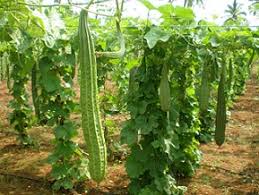
Keeping Your Ridge Gourds Disease-Free
Share
Introduction
Welcome to our comprehensive guide on keeping ridge gourds healthy and thriving by effectively managing diseases. Ridge gourds, known for their versatility and nutritional benefits, are susceptible to various diseases that can affect yield and quality. Whether you're a seasoned gardener or just starting out, understanding the common diseases and proactive measures is crucial for a bountiful harvest. Join us as we explore practical tips and strategies to ensure your ridge gourds remain disease-free throughout their growth cycle. Let's dive in and empower your gardening journey with knowledge and effective practices!

Ridge Gourd Maladies: Unmasking the Culprits
Several diseases can lurk in your ridge gourd patch, threatening your harvest:
Downy Mildew: This fungal disease causes yellow spots on the upper leaf surface, with corresponding water-soaked, fungal patches on the underside. Leaves eventually turn brown and wither.

Powdery Mildew: This fungal disease manifests asa white, powdery coating on leaves and stems, hindering photosynthesis and growth.

Mosaic Virus: This viral disease causes distorted leaves with yellow and green mottling. Affected plants may be stunted and produce fewer fruits.

Fusarium Wilt: This fungal disease causes wilting, yellowing, and eventual death of the plant, starting from the lower leaves.

Natural Defense Strategies: Building a Fortress Against Disease
Seed Selection: Choose diseaseresistant ridge gourd varieties whenever possible.
Seed Treatment: Treat your seeds with neem oil or a copper fungicide before planting to deter fungal pathogens.
Sunlight Savvy: Plant your ridge gourds in a location with good sun exposure and air circulation, as this discourages fungal growth.
Watering Warriors: Water deeply and infrequently, avoiding wetting the foliage. This helps prevent fungal spores from spreading.
Scouting and Sanitation: Vigilance is Key
Regularly inspect your ridge gourd plants for signs of disease. Early detection can make a world of difference in controlling outbreaks. Look for discoloration, unusual spots, wilting leaves, or powdery coatings. Remove and destroy any infected plant parts to prevent further spread.
Organic Options & Chemical Control
Organic Options for a Gentle Touch
For specific diseases, organic options like neem oil sprays, potassium bicarbonate solutions, or milk sprays might be effective. However, always prioritize preventative measures and consult a gardening expert for recommendations on the most suitable organic options for your specific situation.

Chemical Control as a Last Resort
If all else fails, consider using a fungicide or insecticide specifically labeled for ridge gourd diseases. Remember, prevention is key, and using harsh chemicals should be a last resort.

Conclusion
Maintaining disease-free ridge gourds requires a proactive approach that includes both preventive measures and timely interventions. By ensuring proper soil health, adequate spacing between plants, and regular monitoring for early signs of diseases, you can significantly reduce the risk of infections. Implementing organic practices, such as crop rotation and natural pest repellents, further enhances the resilience of your ridge gourd crop. Remember, a healthy garden starts with careful attention to detail and proactive care, ensuring a bountiful harvest of vibrant and disease-free ridge gourds.
